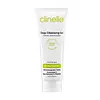What's inside
What's inside
 Key Ingredients
Key Ingredients

 Benefits
Benefits

 Concerns
Concerns

 Ingredients Side-by-side
Ingredients Side-by-side

Water
Skin ConditioningDecyl Glucoside
CleansingAcrylates Copolymer
Cocamidopropyl Betaine
CleansingPPG-26-Buteth-26
Skin ConditioningPEG-40 Hydrogenated Castor Oil
EmulsifyingPhenoxyethanol
PreservativePEG-90 Glyceryl Isostearate
CleansingCoco-Glucoside
CleansingGlyceryl Oleate
EmollientChlorphenesin
AntimicrobialSodium Hydroxide
BufferingCitric Acid
BufferingLaureth-2
CleansingBisabolol
MaskingCitrus Limon Peel Oil
MaskingLavandula Hybrida Oil
EmollientO-Cymen-5-Ol
AntimicrobialTocopheryl Acetate
AntioxidantPropylene Glycol
HumectantMenthyl Lactate
MaskingArnica Montana Flower Extract
MaskingHelianthus Annuus Seed Oil
EmollientAloe Barbadensis Leaf Juice
Skin ConditioningTocopherol
AntioxidantHydrogenated Palm Glycerides Citrate
EmollientLecithin
EmollientPanax Ginseng Root Extract
EmollientHedera Helix Extract
AntimicrobialAscorbyl Palmitate
AntioxidantAsiaticoside
AntioxidantAsiatic Acid
Skin ConditioningMadecassic Acid
Skin ConditioningCamellia Sinensis Leaf Extract
AntimicrobialPotassium Sorbate
PreservativeSodium Benzoate
MaskingWater, Decyl Glucoside, Acrylates Copolymer, Cocamidopropyl Betaine, PPG-26-Buteth-26, PEG-40 Hydrogenated Castor Oil, Phenoxyethanol, PEG-90 Glyceryl Isostearate, Coco-Glucoside, Glyceryl Oleate, Chlorphenesin, Sodium Hydroxide, Citric Acid, Laureth-2, Bisabolol, Citrus Limon Peel Oil, Lavandula Hybrida Oil, O-Cymen-5-Ol, Tocopheryl Acetate, Propylene Glycol, Menthyl Lactate, Arnica Montana Flower Extract, Helianthus Annuus Seed Oil, Aloe Barbadensis Leaf Juice, Tocopherol, Hydrogenated Palm Glycerides Citrate, Lecithin, Panax Ginseng Root Extract, Hedera Helix Extract, Ascorbyl Palmitate, Asiaticoside, Asiatic Acid, Madecassic Acid, Camellia Sinensis Leaf Extract, Potassium Sorbate, Sodium Benzoate
Water
Skin ConditioningAmmonium Lauryl Sulfate
CleansingSodium Cocoyl Alaninate
Cocamidopropyl Betaine
CleansingAcrylates/C10-30 Alkyl Acrylate Crosspolymer
Emulsion StabilisingButylene Glycol
HumectantLactic Acid
BufferingPEG-8
HumectantSodium Hydroxide
BufferingMelia Azadirachta Leaf Extract
Skin ConditioningPropylene Glycol
HumectantGluconolactone
Skin ConditioningMandelic Acid
AntimicrobialCentella Asiatica Leaf Extract
Skin ConditioningSalicylic Acid
MaskingDextrin
AbsorbentPolydextrose
HumectantAmylopectin
Niacinamide
SmoothingMethylchloroisothiazolinone
PreservativeMethylisothiazolinone
PreservativePhenoxyethanol
PreservativeWater, Ammonium Lauryl Sulfate, Sodium Cocoyl Alaninate, Cocamidopropyl Betaine, Acrylates/C10-30 Alkyl Acrylate Crosspolymer, Butylene Glycol, Lactic Acid, PEG-8, Sodium Hydroxide, Melia Azadirachta Leaf Extract, Propylene Glycol, Gluconolactone, Mandelic Acid, Centella Asiatica Leaf Extract, Salicylic Acid, Dextrin, Polydextrose, Amylopectin, Niacinamide, Methylchloroisothiazolinone, Methylisothiazolinone, Phenoxyethanol
 Reviews
Reviews

Ingredients Explained
These ingredients are found in both products.
Ingredients higher up in an ingredient list are typically present in a larger amount.
Cocamidopropyl Betaine is a fatty acid created by mixing similar compounds in coconut oil and dimethylaminopropylamine, a compound with two amino groups.
This ingredient is a surfactant and cleanser. It helps gather the dirt, pollutants, and other impurities in your skin to be washed away. It also helps thicken a product and make the texture more creamy.
Being created from coconut oil means Cocamidopropyl Betaine is hydrating for the skin.
While Cocamidopropyl Betaine was believed to be an allergen, a study from 2012 disproved this. It found two compounds in unpure Cocamidopropyl Betaine to be the irritants: aminoamide and 3-dimethylaminopropylamine. High-grade and pure Cocamidopropyl Betaine did not induce allergic reactions during this study.
Learn more about Cocamidopropyl BetainePhenoxyethanol is a preservative that has germicide, antimicrobial, and aromatic properties. Studies show that phenoxyethanol can prevent microbial growth. By itself, it has a scent that is similar to that of a rose.
It's often used in formulations along with Caprylyl Glycol to preserve the shelf life of products.
Propylene Glycol is an odorless, colorless liquid. As a humectant, it helps skin retain moisture. It also aids in delivering active ingredients.
Another role of this ingredient is preventing a product from melting or freezing. Propylene glycol also adds antimicrobrial properties to a product, elongating product lifespan.
This ingredient is considered an organic alcohol and commonly added into both cosmetics and foods.
Those with sensitive skin or conditions may develop a rash when using this ingredient.
Learn more about Propylene GlycolSodium Hydroxide is also known as lye or caustic soda. It is used to adjust the pH of products; many ingredients require a specific pH to be effective.
In small amounts, sodium hydroxide is considered safe to use. However, large amounts may cause chemical burns due to its high alkaline.
Your skin has a natural pH and acid mantle. This acid mantle helps prevent harmful bacteria from breaking through. The acid mantle also helps keep your skin hydrated.
"Alkaline" refers to a high pH level. A low pH level would be considered acidic.
Learn more about Sodium HydroxideWater. It's the most common cosmetic ingredient of all. You'll usually see it at the top of ingredient lists, meaning that it makes up the largest part of the product.
So why is it so popular? Water most often acts as a solvent - this means that it helps dissolve other ingredients into the formulation.
You'll also recognize water as that liquid we all need to stay alive. If you see this, drink a glass of water. Stay hydrated!
Learn more about Water